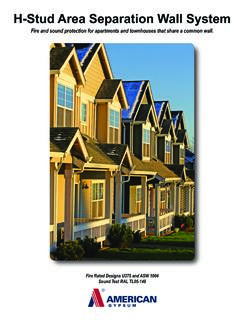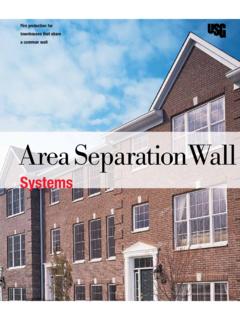Transcription of MANUFACTURED STONE VENEER INSTALLATION GUIDE
1 MANUFACTURED STONE VENEER . INSTALLATION GUIDE . INSTALLATION drawings are available at INTRODUCTION. Environmental StoneWorks takes pride in being the leader in our industry. As a founding member of the Masonry VENEER Manufacturers Association (MVMA), we have helped to develop the highest standards for the INSTALLATION of MANUFACTURED STONE VENEER , as seen here in our INSTALLATION GUIDE . WORKMANSHIP. This INSTALLATION GUIDE assumes that construction personnel have knowledge of the materials described and their proper methods of INSTALLATION . Prior to commencing activity related to the scope of this GUIDE , review all adjacent products and other subcontractor's work that precedes the INSTALLATION of MANUFACTURED STONE VENEER to ensure that proper workmanship is reflected and that there are no recognizable errors or deficiencies.
2 BUILDING CODE REQUIREMENTS. This INSTALLATION GUIDE is intended for use with Environmental StoneWorks MANUFACTURED STONE VENEER and accessories. Environmental StoneWorks INSTALLATION instructions follow the requirements set forth in ASTM C 1780. Building code requirements vary from area to area. Check with local authorities for building code requirements and/or site specific drawings for your area and application. Carefully read all sections of this GUIDE before proceeding with your MANUFACTURED STONE VENEER application. SAFETY REQUIREMENTS. Construct and maintain scaffolding in strict conformity with manufacturer's recommendations and OSHA regulations.
3 In accordance with OSHA regulations, provide fall protection for installers exposed to fall hazards. Confirm installer compliance with OSHA regulations by reviewing written safety programs and training documentation. Environmental StoneWorks INSTALLATION team complies with all OSHA regulations and will provide documentation upon request. Disclaimer: This INSTALLATION GUIDE follows published MVMA and IAPMO specifications. Check your state building guidelines and codes for additional INSTALLATION information. updated: July 2015. TABLE OF CONTENTS. Page 3: MATERIAL REQUIREMENTS. MANUFACTURED STONE VENEER Flashing / Weep Screeds / Casing Bead / Movement Joints Page 4: MATERIAL REQUIREMENTS.
4 Water Resistive Barrier (WRB). Rainscreen Lath Page 5: MATERIAL REQUIREMENTS. Fasteners Mortar Page 6: SURFACE PREPARATION. walls and Wall Systems Masonry walls , Poured-in-Place Concrete walls and Concrete Tilt Up Panels Existing Masonry Surfaces Open Studs, Non-Rigid Sheathing and Metal Siding Exterior Rigid Continuous Insulation (Rigid Foam Insulation). Page 7: CLEARANCES. Page 8: INSTALLATION OF MANUFACTURED STONE VENEER . Mortar Scratch Coat Grout Joints Page 9: INSTALLATION OF MANUFACTURED STONE VENEER . Panel Products Page 10: INSTALLATION OF MANUFACTURED STONE VENEER . Jointless or Drystack Interior Applications Cold Weather Applications Hot Weather Applications Page 11: MAINTENANCE AND CARE.
5 Scuffing Cleaning Efflorescence Sealing Disclaimer: This INSTALLATION GUIDE follows published MVMA and IAPMO specifications. Check your state building guidelines and codes for additional INSTALLATION information. 2. MATERIAL REQUIREMENTS. MANUFACTURED STONE VENEER . 1. Environmental StoneWorks STONE VENEER is engineered from Portland cement, light weight aggregates, mineral oxide and chemical additives. The product is engineered to achieve a specified strength, color, texture and resistance to effects of weathering. 2. Environmental StoneWorks MANUFACTURED STONE VENEER is engineered in various shapes and patterns to simulate natural STONE and is installed in a non-load bearing VENEER and trim capacity ( drip ledge and quoins, caps etc.)
6 3. Thickness: to 2 . 4. Weight: maximum of 15 lbs. per square foot 5. Environmental StoneWorks MANUFACTURED STONE VENEER product integrity test results are available upon request FLASHING / WEEP SCREEDS / CASING BEAD / MOVEMENT JOINTS. The weep screed should be corrosion resistant metal minimum or No. 26 galvanized sheet gauge, or a plastic weep screed minimum , and with a minimum vertical attachment flange of 3 wide. All flashing and metal detail pieces should be MANUFACTURED of corrosion resistant material. Verify that all flashing, including roofing kickout flashing, have been properly installed. Although roof flashings are not part of the wall cladding system, they are necessary for proper moisture management.
7 Flashing material should extend above horizontal terminations, roofing material and drainage planes or drainage products. All flashing material should be integrated with water resistive barriers to prevent moisture penetration into structure. The WRB should overlap the weep screed flange. A minimum space, adequate sealant, and optional casing bead should be utilized where there is concern for dissimilar material separation. Control Joints & Expansion Joints Do not install MANUFACTURED STONE VENEER over these joints. Disclaimer: This INSTALLATION GUIDE follows published MVMA and IAPMO specifications. Check your state building guidelines and codes for additional INSTALLATION information.
8 3. MATERIAL REQUIREMENTS. WATER RESISTIVE BARRIER (WRB). Minimum two separate layers of any of the following: No. 15 felt complying with ASTM D 226 for Type 1 felt, or Grade D paper (ICC-ES AC38), or house wrap (ICC-ES AC 38), or any combination two separate layers of these materials. One layer paper-backed lath meeting requirements for Grade D paper may be substituted for the outer layer. Install WRB in a shingle fashion, starting from the bottom of the wall. The inner layer of WRB should be installed, along with flashings, to create a drainage plane. The outer layer of WRB is intended to keep the scratch coat from contacting the inner layer of WRB.
9 The upper layer of WRB should lap on top of the lower layer by a minimum of 2 . The vertical joints of WRB. must be lapped a minimum of 6 . Inside and outside corners must be overlapped a minimum of 12 past the corner in both directions. The WRB. should be installed in accordance with manufacturer's recommendations and be integrated with all flashing accessories, adjacent WRBs, doors, windows, penetrations and cladding transitions. RAINSCREEN. Rainscreen building techniques have been used in construction for many years. These techniques are typically used to improve the escape of incidental water and decrease drying time.
10 Rainscreen products (such as drainage mats or formed polymer sheeting) or construction techniques (such as strapping or furring) that create a capillary break/air space between the cladding and the primary water resistive barrier can be effectively incorporated into MANUFACTURED STONE VENEER applications. Refer to the rainscreen /. drainage system manufacturer's recommendation for applications with MANUFACTURED STONE VENEER wall systems. Building codes may allow a single layer of WRB when a designed drainage space is incorporated in the wall system ( rainscreen). LATH. All lath and lath accessories must be made of corrosion resistant material.





